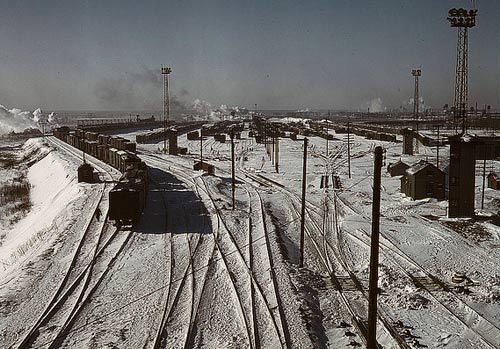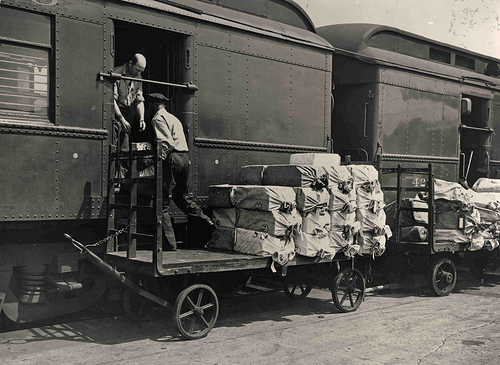I’m currently reading a book Blood, Iron and Gold by Christian Wolmar about how railways transformed the world.

This interesting extract from the political economist Friedrich List, explains some of the economic benefits of railways:
“Railways would carry wood, turf and coal at less than half the present costs. Bavaria, where flour, meat and other foodstuffs are 50 – 100 per cent cheaper than in Leipzig, could export its surplus to the Erzgebirge, the Elbe and the Hanseatic cities. Cheaper food and fuel would partly enhance the well-being of the working classes, and partly lower money wages, increase population and increase the extent of industry. Cheap building materials and low money wages would encourage building and lower the rents in the new and more distant parts of the city.” …. I do not doubt for one minute that this increase in value in Leipzig alone would in a few years exceed the total capital costs of the new railways.” Leipzig-Dresden railway” [1]
In one paragraph, quite a few interesting areas of economic theory.
- New technology leading to lower average cost for business. The introduction of the railways enabled a substantial reduction in costs of transport, leading to lower prices of goods in shops. The new stream railway technology quite possibly had a bigger impact on business than recent technological innovations, such as micro-computers and the internet.
- Theory of comparative advantage. This extract shows Bavaria has a comparative advantage in foodstuffs (50-100% cheaper) Exporting surplus foodstuffs led to increased economic welfare for both Bavaria (exporters) and the cities (cheaper imports). Presumably, exporting food, would give Bavaria more income to spend on goods and services produced in the cities. This theory of comparative advantage is no use, if there are prohibitive transport costs. The railways enable these potential gains to be materialised.
- Improved living standards. ‘Partly lower money wages’ The author may mean that with lower food prices and lower building costs, real living standards rise. Your wages go further, if the railways make everything cheaper. The author is perhaps suggesting wages can be cut because the price of goods haven fallen.
- Greater choice of goods and services. The railways enable a greater choice of goods. Fish and chips became a popular meal when people could now transport fresh fish in a day. The diet of many people improved after the introduction of the railways because a greater variety of fresh food could be brought in.
- New markets. The railways led to the creation of new industries like tourism. Coastal towns like Blackpool and Scarborough became popular seaside resorts. Thomas Cook’s travel business started from offering special charter trains.
- Economic growth. The consequence of lower prices and lower costs is to encourage investment and spending. Many projects are now profitable that weren’t before. Railways are increasing the productive capacity of the economy, shifting aggregate supply to the right.
Other economic consequences of the railways
- Created new journeys. Many felt the railways would take passengers from other forms of transport (like the stagecoach, canal boat and omnibus). But, the railway created a new latent passenger demand. When it was possible to travel from Liverpool to Manchester in a couple of hours (rather than a whole day) Merchants started frequently traveling. People could afford to take a train for a shopping excursion they never would have considered. Railways proved that if you offer new improved transport services you can create demand that wasn’t there before. It is like the modern phenomena of building new roads and finding they soon fill up as journeys increase.
- The railway commuter. Before the railways most people lived within walking distance from their place of work. It meant workers often lived in cramped unsanitary conditions close to industrial centres. The railways enabled people to live further afield and catch the train into work. It was the railway which helped the spread of the ‘commuter belt’. In the 1920s, the Metropolitan railway actively marketed ‘Metro land’ – new houses built near railway lines. People started living further away from their place of work. It was now practical to live in the suburbs and commute into the centre of town / city to work.
- New opportunities for industry. Making raw materials easily available at low cost transformed industry.
- Enhanced the process of globalisation. Trains made it much easier to import goods and raw materials. The easy transfer from coast to inland manufacturing enabled firms to source goods from abroad. It is in the railway age where Britain starts becoming a big importer of food, such as tea from India and beef from Argentina.
- Speeded up communication. Mail delivered by train could arrive in a matter of days rather than weeks. The railways helped develop national networks of mail delivery.

Farming. Before the railways, farmers had to drive their livestock into towns were they would be slaughtered. This was an inefficient process because it would take many days and during the long walk, the animals would lose much of their body weight. The trains enabled cattle to be transported directly into the centre of towns. It was much more profitable for farmers as the cattle would give more meat.
Railways during the First World War
In 1914, trains were perhaps at the height of the dominance of transport. Some scholars have suggested that trains contributed to the defensive nature of the First World War. Railways could easily provide troops, supplies and munitions to positions of defence. However, they lacked the flexibility to help with advancing troops. Trains and railways were useful for supporting strong defensive positions but not attacking troops. Hence one reason for the stalemate of trench warfare. By the time of the second world war, railways had been superseded by motorised transport (tanks) these were much more suitable to advancing (blitzkrieg) forms of war.
Stock markets
The nature of railways was that they required significant capital investment, but companies could not expect profit for several years. To finance the building of railways, companies looked to the stock market to raise finance. In the UK, the building of the railways saw a rapid growth in the number of companies listed on the stock market. More people considered buying shares in railway companies. Railways contributed to the development of banking and stock markets. In the UK, there was a period of railway mania where speculators flocked to buy shares in any railways company. But, some of the schemes were actually unprofitable and people lost parts of their investment.
Government regulation
At the start of the railway age, governments generally followed a laissez faire approach to business. Early railways were privately owned, financed with little or no government regulation. However, the growth of the railways was important for changing governments attitudes. Slowly governments saw the need to regulate aspects of railway safety (after high profile crashes). Railways also lent itself to monopoly power; many of the late Nineteenth Century railway companies were successful in charging high prices and exploiting their monopoly power. Governments started to regulate these monopoly trusts. In 1887, US congress passed the Interstate Commerce Act, which regulated monopoly power.
Nationalisation and subsidies
The Twentieth Century saw railways fade. They became unprofitable as the motor car proved more efficient for transport. However, governments saw a need to subsidise loss making railways because of their social benefit. Railways may be unprofitable in a free market, but they play a role in reducing traffic congestion, and lower pollution levels. Railways have been effectively nationalised in both UK and US. After a prolonged period of decline in the UK – since the 1980s, trains have seen rapid recovery as crowded roads have forced people to find alternative means of transport.
There are many more aspects to how railways changed society, not least uniting nations, changing the nature of war and leading to greater freedom of movement and work.
Related

thanks bro